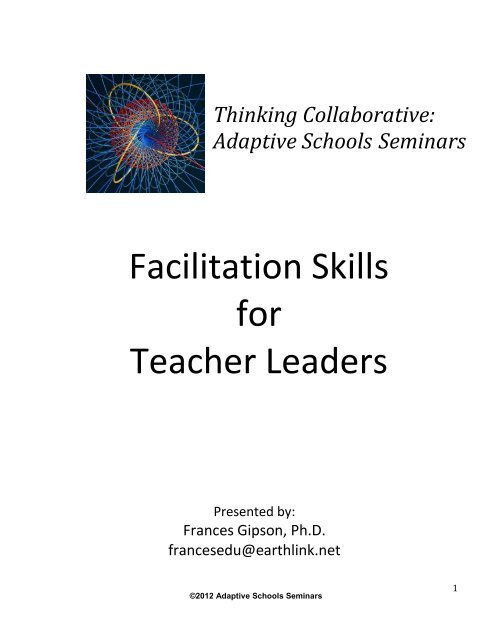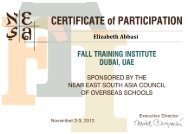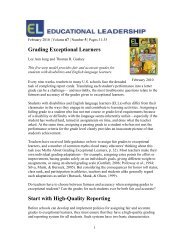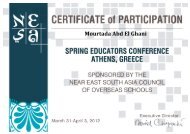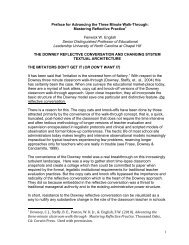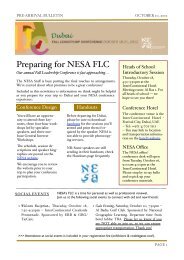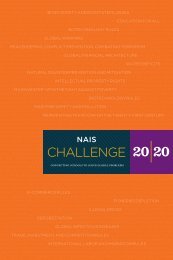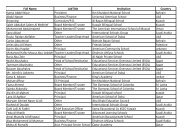Facilitation Skills for Teacher Leaders Handout - NESA
Facilitation Skills for Teacher Leaders Handout - NESA
Facilitation Skills for Teacher Leaders Handout - NESA
Create successful ePaper yourself
Turn your PDF publications into a flip-book with our unique Google optimized e-Paper software.
Strategies!©2012 Adaptive Schools Seminars 4
ACADEMIC OPTIMISM OF SCHOOLSWayne K. Hoy, C. John Tarter, Anita Woolfolk Hoy1 - Academic Emphasis of SchoolsAcademic emphasis is the extent to which the school is driven by a quest <strong>for</strong> academicexcellence—a press <strong>for</strong> academic achievement. High, but achievable academic goals are set<strong>for</strong> students; the learning environment is orderly and serious; students are motivated to workhard; and students respect academic achievement (Hoy & Miskel, 2005; Hoy, Tarter, &Kottkamp, 1991).Hoy and his colleagues (Hoy, Tarter, & Kottkamp, 1991) were first to demonstrate that thecollective property academic emphasis of the school was positively and directly related tostudent achievement in high schools while controlling <strong>for</strong> SES. Whether school effectivenesswas conceived as the commitment of teachers to the school, the teachers’ judgment of theeffectiveness of the school, or actual student test scores, academic emphasis remained apotent <strong>for</strong>ce. At both middle school and high school, academic emphasis and achievementwere positively related even controlling <strong>for</strong> socioeconomic factors (Hoy, Tarter, & Bliss, 1990;Hoy & Hannum, 1997; Hoy and Sabo, 1998).The findings are the same <strong>for</strong> elementary schools. Goddard, Sweetland, and Hoy (2000),controlling <strong>for</strong> SES, school size, student race, and gender, used hierarchical linear modeling tofind academic emphasis an important element in explaining achievement in both math andreading. The authors concluded, “...elementary schools with strong academic emphasespositively affect achievement <strong>for</strong> poor and minority students” (p. 698).Alig-Mielcarek and Hoy (2005) considered the influence of the instructional leadership of theprincipal and the academic press of the school. They also found that academic emphasis wassignificant in explaining student achievement, even controlling <strong>for</strong> SES. Using structuralequation modeling, they found that academic emphasis of the school, not instructionalleadership, was the critical variable explaining achievement. In fact, instructional leadershipworked indirectly, not directly, through academic press to influence student achievement.Using different methodological approaches and school levels, the results are consistent.Whether the analysis was multiple regression, structural equation modeling, or hierarchicallinear modeling, and whether the level was elementary, middle, or secondary, the findings arethe same: academic emphasis is a key variable in explaining student achievement, evencontrolling <strong>for</strong> socioeconomic status, previous achievement, and other demographic variables.©2012 Adaptive Schools Seminars7
achievement. Research has consistently demonstrated the power of positive efficacy judgments inhuman learning, motivation, and achievement in such diverse areas as dieting, smoking cessation,sports per<strong>for</strong>mance, political participation, and academic achievement (Bandura, 1997; Goddard,Hoy, & Woolfolk Hoy, 2004). Similarly, the results of the school studies reported above underscorethe importance of collective efficacy. Collective efficacy is grounded in Bandura’s social cognitivetheory (Bandura, 1997); hence, we turn to his sources of efficacy <strong>for</strong> ideas about how to buildcollective efficacy in schools. The sources of self-efficacy are mastery experiences, vicariousexperiences, social persuasion, and affective states, each of which conveys in<strong>for</strong>mation thatinfluences teacher perceptions about the school (Bandura, 1993, 1997; Goddard, Hoy, & WoolfolkHoy, 2004; Pajares, 1997). For example, let’s consider a school with a poor graduation rate. Aneighboring district has implemented a successful program <strong>for</strong> at-risk students. The principal is inthe position to orchestrate the transfer of the neighbor’s success to his or her school. In so doing,the school is engaged in a self-regulatory process in<strong>for</strong>med by the vicarious learning of itsmembers and, perhaps, the social persuasion of leaders. Modeling success and persuadingteachers to believe in themselves and their capabilities is a reasonable route to improve collectiveefficacy and enhance academic optimism (Bandura, 1997; Goddard, Hoy, & Woolfolk Hoy, 2004).10
3-Faculty Trust in Parents and StudentsFaculty trust in parents and students is the third school property that is related to studentachievement. Faculty trust in parents and students is a collective school property in same fashionas collective efficacy and academic emphasis. Surprisingly, trust in parents and trust in students isa unitary concept. Although one might think that the two are separate concepts, several factoranalyses have demonstrated they are not (Hoy & Tschannen-Moran, 1999; Goddard, Tschannen-Moran, and Hoy, 2001). Further, Bryk and Schneider (2002) make the theoretical argument thatteacher-student trust in elementary schools operates primarily through teacher-parent trust.Trust is one’s vulnerability to another in the belief that the other will act in one’s best interests.Tschannen-Moran and Hoy (2000), after an extensive review of the literature, concluded that trustis a general concept with at least five facets: benevolence, reliability, competence, honesty, andopenness. Although it is theoretically possible that these facets of trust may not vary together, theresearch on schools shows all five facets of trust in schools do indeed vary together to <strong>for</strong>m anintegrated construct of faculty trust in schools, whether the schools are elementary (Hoy &Tschannen-Moran, 1999; Hoy & Tschannen-Moran, 2003) or secondary (Smith, Hoy, & Sweetland,2001). Thus, we defined faculty trust as the group’s willingness to be vulnerable to another partybased on the confidence that the latter party is benevolent, reliable, competent, honest, and open(Hoy & Tschannen-Moran, 2003).Cooperation and trust should set the stage <strong>for</strong> effective student learning, but only a few studieshave examined this relationship. Goddard, Tschannen-Moran, and Hoy (2001) examined the roleof faculty trust in promoting school achievement of urban elementary schools. Using a multi-levelmodel, they demonstrated a significant direct, relationship between faculty trust in clients (studentsand parents) and higher student achievement, even controlling <strong>for</strong> socioeconomic status. Likecollective efficacy, faculty trust was a key property that enabled school to overcome some of thedisadvantages of low SES.Hoy (2002) examined the trust-achievement hypothesis in high schools and again found thatfaculty trust in parents and students was positively related to student achievement while controlling<strong>for</strong> socioeconomic factors. He theorized that trusting others is a fundamental aspect of humanlearning because learning is typically a cooperative process, and distrust makes cooperationvirtually impossible. When students, teachers, and parents have common learning goals, then trustand cooperation are likely ingredients that improve teaching and learning.Finally, Bryk and Schneider (2002) per<strong>for</strong>med a three-year longitudinal study in 12 Chicagoelementary schools. Using HLM models, survey and achievement data, and in-depth interviews,they concluded that relational trust was a prime resource <strong>for</strong> school improvement. Trust andcooperation among students, teachers, and parents influenced regular student attendance,persistent learning, and faculty experimentation with new practices. In brief, trust among teachers,parents, and students produced schools that showed marked gains in student learning, whereasschools with weak trust relationships saw virtually no improvement. The research of Bryk andSchneider and that of Hoy and his colleagues rein<strong>for</strong>ce each other in the common conclusion thatfaculty trust of students and parents enhances student achievement.11
There is some research on family and community involvement in schools (cf., Epstein, 1989);however, there is little systematic research on how to build authentic trust. Faculty trust in studentsand parents can be promoted through useful interchanges, both <strong>for</strong>mal and in<strong>for</strong>mal, betweenparents and teachers. Making the most of vicarious learning, <strong>for</strong> example, a school can respond toa lack of trust and community participation in school activities by emulating the practices andprocedures magnets schools known <strong>for</strong> their parental cooperation and involvement. But muchmore research is needed about what programs and factors support the development of teachers’trust in parents and students. Such examples demonstrate how changes in social perceptionsinfluence what actions organizations choose to pursue. Collective perceptions about efficacy,academic emphasis, and trust shape the school’s normative environment and can be developedthrough experiences that convey their value.12
Three Focus AreasProductive group work is organized by three focus areas:• Facilitating Groups• Developing Groups• Becoming a More Skillful Group MemberThese three arenas are essential focus areas <strong>for</strong> all successful groups. This seminaroffers concepts, tips and tools <strong>for</strong> extending and refining skills in each of theseterritories.Facilitating Groups<strong>Facilitation</strong> is an act of planned improvisation. Skilled and confident facilitatorspay attention to several dimensions simultaneously: task focus, process skillsdevelopment and relationships within the group. With appropriate maps andtools, knowledgeable facilitators are able to: anticipate what might happen duringa session; monitor both in-the-moment activities and actions and monitor wheresuch actions fit within the bigger picture <strong>for</strong> the group and <strong>for</strong> the organization;and recover when the group, group members or they themselves lose focus anddirection.Developing GroupsOur basic premise is that groups develop from novice to more expert levels ofper<strong>for</strong>mance. Expertise does not always result from time together or from basiclevels of task completion. Expert groups consciously develop their capacities andtoolkits <strong>for</strong> engaging in more complex work and more emotionally challengingtasks. One hallmark of emerging expertise is a group’s willingness make time toreflect on it processes, products and development as a group. Groupdevelopment is a shared responsibility between group leaders, group facilitatorsand group members.Becoming a more skillful group memberAt a fundamental level there is no such thing as group behavior, there are only thechoices that individuals make about what to say or do and what they choose notto say or do. Expert group members employ a well-crafted set of verbal andnonverbal tools to productively influence the thinking, decisions and choices ofothers in the group. They also monitor the effects of their choices on themselvesand the impacts of their actions as other group members respond or choose notto respond to these actions. Skillful group members help the group and thefacilitator maintain focus, momentum and outcome achievement.13
The Confident and Skilled FacilitatorA facilitator manages processes so that a group can plan, problem-solve, sharein<strong>for</strong>mation, evaluate, and make decisions efficiently and effectively. A facilitator alsoworks to improve group members’ ability to work together effectively and helps groupsto improve their processes.Because facilitators are nondirective regarding meeting content, some misconstrue thisto mean that the role is a passive one. Nothing could be further from the truth. Thefacilitator is the group’s instrument <strong>for</strong> sound process choices that will lead to the fullexpression and understanding of relevant ideas and in<strong>for</strong>mation. The facilitator supportsaccess to the diversity of group resources, sound decision making, and problem-solvingef<strong>for</strong>ts.A highly skilled facilitator is much like an accomplished dancer. One notices the dancebut not the dancer. She directs process yet is supremely flexible. She follows principles, notrules. She improvises. She knows her own cognitive styles and stretches beyond them whenit serves the group. She is com<strong>for</strong>table with who she is and sets aside judgments aboutothers. She is clear in the moment about her intentions. She thinks beyond activities tooutcomes. She is reflective and learns from experience. She can direct or request, be firmor soft, serious or light, focus on task or on relationships. She has abundant knowledgeabout processes and groups. She is ef<strong>for</strong>tlessly competent with many facilitation moves.Above all, the facilitator is an observer who helps groups to mediate tensions.Every system is influenced by demands that present mixed messages. The principal whoresponds to the demands of the central office can create the conditions <strong>for</strong> parents todemand a charter school. <strong>Teacher</strong>s who are driven by student learning needs might workin opposition to the demands of the state assessment system. Parents and teachers lookat a system through different eyes. Each day, there are different interpretations of thesame data, and the stakeholders are responding from different perspectives. A facilitatorserves the system by bringing the different perspectives to consciousness.This chapter of The Adaptive Schools Sourcebook addresses the requirements <strong>for</strong>facilitators, the tasks during the various stages of facilitation, and ways to developconfidence. A special section is included on how a “citizen facilitator” solves the problem ofmaintaining facilitation services even in very small work groups.<strong>Facilitation</strong> Compared to Other <strong>Leaders</strong>hip Roles<strong>Facilitation</strong> is similar to but significantly different from three other leadership roles:presenting, consulting, and coaching. Groups need clear role definitions because what arole is called influences people’s expectations. The most common error we’ve noticed is<strong>for</strong> the presenter and facilitator titles to be used interchangeably. A facilitator is not apresenter and a presenter is not a facilitator, just as a Ford is not a Honda and vice versa.In the latter case, both are vehicles. In the <strong>for</strong>mer, both are leadership functions withimportant differences.In a professional community—an adaptive organization—leadership is shared; thatis, all the participants play all the roles. All the participants must have the knowledge andskills to manage themselves and to manage others. <strong>Leaders</strong>hip is a shared function in©2012 Adaptive Schools Seminars 8
meetings, in staff development activities, in research, and in projects. Recognizing what wehave called the four hats of leadership (see chapter 2) and knowing when and how tochange them becomes shared knowledge within the organization. When values, roles, andwork relationships are clear, decisions about appropriate behavior are easy.The following definitions illustrate the four leadership functions and the distinctionsamong those roles:• To facilitate means to “make easier.” A facilitator conducts meetings whosepurpose is dialogue, shared decision-making, planning, or problem solving. Thefacilitator directs the procedures used in the meeting, choreographs the energy withinthe group, and maintains a focus on one content and one process at a time. Thefacilitator should rarely be the person in the group with the greatest role or knowledgeauthority.• To present is to teach. A presenter’s goals are to extend and enrich knowledge,skills, or attitudes and to help these to be applied in people's work. A presenter mayadopt many stances (expert, colleague, novice, or friend) and use many strategies ofpresentation (lecture, cooperative learning, or study groups). Premier presenters areguided by clarity of instructional outcomes and the continual assessment of goalachievement.• To coach is to help a group take action toward its goals while simultaneouslyhelping it develop expertise in planning, reflecting, problem solving and decision- making.The coach takes a nonjudgmental stance and uses tools of open-ended questions,pausing, paraphrasing and probing <strong>for</strong> specificity. The skillful coach focuses on theperceptions of group members and their thinking and decision-making processes todevelop the resources <strong>for</strong> self-directed learning.• To consult means to be an in<strong>for</strong>mation specialist or an advocate <strong>for</strong> content orprocess. As an in<strong>for</strong>mation specialist, the consultant delivers technical knowledge to agroup. As a content advocate, the consultant encourages group members to use acertain strategy, adopt a particular program, or purchase a specific brand of equipmentor material. As a process advocate, the consultant attempts to influence the group’smethodology (e.g., recommending an open meeting rather than a closed one in orderto increase trust in the system). To consult effectively, one must have trust, commonlydefined goals, and the group’s desired outcomes clearly in mind.Facilitators are substantially neutral to content. We periodically witness meetings inwhich colleagues ask the group member who is facilitating to add to the conversation.Wanting to know this person’s ideas is certainly understandable, but it is a disservice tothe group to lose a content-neutral facilitator. The strategy Signal Role Change (seeAppendix A) permits the facilitator to step out of the role to comment and yet protectthe integrity of the role.©2012 Adaptive Schools Seminars 9
<strong>Leaders</strong>hip HatsPresentingFacilitatingFour Hats ofShared<strong>Leaders</strong>hipConsultingCoaching10©2012 Adaptive Schools Seminars
“The Four Currents of<strong>Facilitation</strong> Management”©2012 Adaptive Schools Seminars 11
The Five C’s: The Qualities of a Good FacilitatorFacilitating a meeting is improvisational work, requiring a foundation of knowledge andskills, a clear sense of purpose, a juggler’s gift of attending to everything at once, andknowing what to do when you don’t know what to do. You don’t have to be flashy to be agood facilitator, but you do need to be developing the five Cs: clarity, consciousness,competence, confidence, and credibility.ClarityFacilitators must be clear about their role, its boundaries, and its responsibilities,and they must be able to communicate this unambiguously to the groups with whomthey work. They need to know to whom they are ultimately responsible. See AppendixF <strong>for</strong> the distinctions among a contact, intermediate, or primary client. Facilitatorsknow the importance of language and strive <strong>for</strong> precision. The following list showssome examples of facilitator language:• To get attention. “Look this direction.”• To clarify purpose. “Today’s task is to [approve, generate, select, identify,explore, resolve].”• To give directions. “Identify some ideas you would like to explore as a team.Prepare to share your two most important ideas.”• To encourage participation. “Here are some suggestions <strong>for</strong> how to get themost value out of today’s meeting. Be responsible <strong>for</strong> your com<strong>for</strong>t andlearning. Don’t wait <strong>for</strong> a break to make yourself com<strong>for</strong>table. Be responsibleas well <strong>for</strong> your learning. If you can’t hear someone, say ‘Louder, please!’ Ifsomeone is speaking too abstractly and you need a concrete example, please ask <strong>for</strong>it.”• To enlarge perspective. “Who is not in this room and can’t speak <strong>for</strong> themselves onthe topic? What do you imagine their concerns might be?”• To invite group awareness. “How is the group doing on its norm of listening to oneanother? Tell your partner.”• To foster understanding. “Who might offer a summary paraphrase?”• To encourage agreements. “Are you ready <strong>for</strong> a decision?”Language can obscure or clarify. Precise language is a gift to the facilitator andthe group. It saves time and frustration, eliminates ambiguity, conveys respect <strong>for</strong> thegroup, and fosters facilitator credibility. Attaining language precision can be a usefullifetime goal regardless of one’s role. Strive to be organized, brief, and specific. Usewords and phrases that have one meaning. Use nouns more than pronouns. Tell thegroup what it is to do, why or how that relates to the bigger context of its work, and thespecific intention to be achieved at each stage. Use advanced organizers like “Thereare three steps. Number 1 is . . . ”©2012 Adaptive Schools Seminars 12
ConsciousnessFacilitators are simultaneously aware of multiple events in the external environment and intheir internal world. They work to hone their sensory acuity. Of the 11 million bits of databombarding a person every second, 10 million come through the eyes. Facilitators pick upcues that group members are engaged, socializing, fatigued, impatient, apathetic, curious,excited, or just going through the motions. Facilitators can detect nuances in voice tone andhear even when they are turned away from the group. They pay attention to breathing, roomtemperature, and sight lines. They shuttle from looking outward to looking inward. Facilitatorsmaintain their own resourcefulness, take stock of their energy, notice when they might bemaking poor judgments, remind themselves of context, and assess their relationship with thegroup. The facilitator’s internal focus must complement, not dominate, the external awareness.Facilitators stay aware of multiple outcomes and contexts. Most meetings are nestedinside other circumstances or initiatives. Perhaps most important, facilitators are aware oftheir point of view at any given time, and they press themselves to understand interactionsfrom various perspectives. Facilitators know that success often depends on their ability tosee things in new ways, gain new understandings, and produce new patterns of groupinteractions.CompetenceCompetence is the third C. It develops with continuous learning, experience, andreflection on experience. Facilitators’ competencies are grounded in a basic knowledge ofeffective meetings. This includes the distinction between discussion and dialogue (seechapter 4), a set of facilitation strategies (see Appendix A), and four meeting successstructures (see chapter 5). <strong>Skills</strong> competencies include designing an agenda, reading agroup, speaking with precision, paraphrasing, asking mediational questions, beingcom<strong>for</strong>table with silence, and using a host of nonverbal strategies and skills. Competencealso means realizing that a plan is only a map of the territory and having the wisdom toknow when the plan is not working.ConfidenceConfidence is the fourth C. Extensive literature supports the idea that beliefs aboutoneself translate into actions and results. Facilitator self-confidence is a dimension ofefficacy applied to the specific work of conducting meetings. As previously noted, efficaciouspersons believe that they have knowledge and skills that, when applied to a goal, willovercome any obstacles. Such self-confidence derives from reflection on experiences,conversations with colleagues, and support from coaches or leaders. This chapter closeswith the topic of ways to develop confidence. No one who is beginning to facilitate is a blankslate. Each person begins the journey to increasingly effective facilitation with uniquestrengths and unique things to learn.©2012 Adaptive Schools Seminars 13
CredibilityCredibility, the fifth C, is a by-product of the other four; like permission, it is assigned to thefacilitator by the group. Credibility does not live inside the facilitator; rather, it is a perception thegroup <strong>for</strong>ms about the person. When a group believes that a facilitator is competent, confident,neutral, trustworthy, and fair, the group can say that this person is credible.Credibility, like trust, can temporarily be lost. Being less than honest, not owning mistakes, orspeaking disrespectfully about those who are not in the room will drive a wedge of discom<strong>for</strong>tbetween you and the group. One essential facilitator capacity is learning how to recover frommistakes. As a friend of ours says, if you step in it, know how to step out of it.The strongest element of a recovery move is to step away from the place you made the error.This strategy is called Visual Paragraph (see Appendix A). Acknowledge whatever you did thatevoked discom<strong>for</strong>t. Take responsibility (“I’m sorry, I was supposed to bring that to you today, andI <strong>for</strong>got”), apologize (“That was insensitive, please accept my apology”), self-disclose (“Did I saythat?”—pointing to the space you just left), or direct some humor at yourself (“I always wanted tobe skillful, now I realize I should have specified at what”). These are some unassuming ways torecover focus and direction.©2012 Adaptive Schools Seminars 14
Facilitator Nonverbals©2012 Adaptive Schools Seminars 15
©2012 Adaptive Schools Seminars 16
Ways of Talking“In order to have a conversation with someone you must reveal yourself.”--- James BaldwinProfessional communities are born and nurtured in webs of conversation. What we talk about in our schools and howwe talk about those things says much about who we are, who we think we are and who we wish to be, both in themoment and in the collective future that we are creating <strong>for</strong> ourselves as colleagues and f or the students we serveTo develop shared understanding and be ready to take collective action, working groups need knowledge andskill in two ways of talking. One way of talking, dialogue, leads to collective meaning making and thedevelopment of shared understanding. The other way of talking, discussion, leads to decisions that stay made.Dialogue honors the social/emotional brain, building a sense of connection, belonging and safety. As ashape <strong>for</strong> conversations, it connects us to our underlying motivations and mental models. This way oftalking <strong>for</strong>ms a foundation <strong>for</strong> coherent sustained ef<strong>for</strong>t and community building. In dialogue we hearphases like “An assumption I have is….” and, “I’d be curious to hear what other people are thinking aboutthis issue.”Discussion in its more skillful <strong>for</strong>m requires conversations that are infused with sustained critical thinking, carefulconsideration of options and respect <strong>for</strong> conflicting points of view. This way of talking leads to decision makingthat serves the group’s and the school’s vision, values and goals. In a discussion we hear phrases like “We needto define the problem we are solving be<strong>for</strong>e jumping to solutions.” and, “I’d like to see the data that theseassumptions are based on be<strong>for</strong>e we go much further.”Conversation and DeliberationWhen groups come together they “converge” and “converse”. These words’ respective Latin roots means thatgroup members “turn together” and “associate with one another." Conversation is in<strong>for</strong>mal talking in whichparticipants share in<strong>for</strong>mation, anecdotes and opinions to learn from one another or simply to enjoy one another'scompany. When the conversation takes on an organized purpose to either deepen understanding or make adecision, a group that understands that there are two ways of talking acknowledges this point of deliberation andconsciously chooses to engage in either dialogue or discussion. Deliberation in its Latin root, deliberare, meansto weigh, as in to evaluate, assess or ponder.Group members have this choice point available to them only when they have roadmaps <strong>for</strong>ways of talking and consciousness about group processes and group purposes. A significantpart of this awareness is recognizing that culturally embedded patterns shape behaviors –patterns from the larger surrounding culture and patterns from organizational and group culture.Many groups default into the Western cultural habit of polarized discussion and debate. Ourmedia-saturated world bombards us with arguments framed by commentators as point-©2012 Adaptive Schools Seminars 17
counterpoint, pro and con, left versus right, and other polarities. These models transfer toconversations in working groups; they then frame how participants listen to others and howand when participants speak. If group members are not careful, they end up listening not tounderstand but to hear gaps in the logic of other speakers, or they interrupt to make a pointeven be<strong>for</strong>e the current speaker is finished. Conversations then break down into verbal combatwith winners and losers.All too often, valued colleagues become conscientious objectors, choosing not to participatein the fray. The group then loses perspective and potential alternative viewpoints. The loudestand most persistent voices become the policy makers, and in the worst cases, the processsows the seeds of passive noncompliance or sabotage in those who feel excluded ordevalued.When groups understand that they have more than one way of talking available to them, theycan then choose to pursue the path of dialogue or to follow the path of discussion. Mostimportant issues require explorations along both pathways. Many sensitive issues, especiallythose with high stakes <strong>for</strong> the participants, call <strong>for</strong> separate sessions in which the dialogueand discussion are separated in time and sometimes space. One useful facilitation techniqueis to explicitly label agenda items as either dialogue or discussion and offer language modelsto further mark the distinctions between the two <strong>for</strong>ms of discourse.As group members become more sophisticated with the ways of talking, the pathwaysbecome more malleable. For example, during a dialogue, a group member senses anemerging consensus on an issue. He or she then inquires if this is so and frames a proposalto move the item to a decision. In another case, during a discussion, emotions rise and thedetails become muddled. Someone then proposes that the group switch to a dialogue <strong>for</strong>mat<strong>for</strong> a set time to explore the feelings and underlying issues that are present.The Path of DialogueDialogue is a reflective learning process in which group members seek to understand oneanother’s viewpoints and deeply held assumptions. The word dialogue comes from theGreek dialogos. Dia means “through” and logos means “word”. In this meaning-makingthrough words, group members inquire into their own and others’ beliefs, values, and mentalmodels to better understand how things work in their world. In dialogue listening is asimportant as speaking. For skilled group members. Much of the work is done internally.Physicist and philosopher David Bohm described dialogue as a process of surfacing andaltering the “tacit infrastructure of thought.” As a quantum physicist, Bohm draws an analogybetween dialogue and superconductivity. Electrons that are cooled to extremely lowtemperatures dramatically change their behavior, operating more as a coherent whole andless as separate parts. In supercool environments, electrons flow around barriers and oneanother without resistance, creating very high energy. The same electrons radically changebehavior in a new environment. At higher temperatures they operate as separate entities withrandom movement and loss of momentum. Dialogue creates an emotional and cognitivesafety zone in which ideas flow <strong>for</strong> examination without judgment. Although many of the©2012 Adaptive Schools Seminars 18
capabilities and tools of dialogue and skilled discussion are the same, their core intentionsare quite different and require different personal and collective monitoring processes.Monitoring DialogueMindful group members pay attention to three essential elements during productive dialogue. They monitorthemselves, the process of the dialogue and the new whole that is emerging within the group.SelfDialogue is first and <strong>for</strong>emost a listening practice. When we “listen to our listening” we notice whetherwe are internally debating with the speaker, reviewing our mental catalogue of related in<strong>for</strong>mation andpersonal anecdotes, or composing a response. Noticing these common internal processes allows usto switch them off so that we can hear others without judging.Dialogue requires choice making. Typical choices include how and when to talk ---- Do we paraphrase priorcomments to check <strong>for</strong> understanding and or synthesize? Do we inquire into the ideas and assumptions ofothers? Or, do we put a new idea or perspective on the table to widen the frame?Suspension is an essential internal skill in dialogue. To suspend judgment, group members temporarily setaside their own perceptions, feelings, and impulses and carefully monitor their internal experience. Points ofpersonal conflict can easily emerge when we believe that others are not hearing us or that they are distorting ourpoint of view. Points of conflict also surface when our own values conflict with those of a speaker. These areasof discom<strong>for</strong>t influence our listening and our responses, which in turn influence the thoughts and behaviors ofother group members.Peter Senge (1994) notes that suspension also involves developing an awareness of our own assumptions andpurposely "hanging them from the ceiling" –, that is suspending them in front of the group so that all canexamine them. These assumptions are beliefs --- often unexamined--- about why we think things work as theydo. Our assumptions drive our perceptions, simultaneously opening and blinding us to possibilities in the worldaround us.ProcessDialogue as a process requires focusing on the goal of developing shared understanding. In our action- orientedwork environments, this is often countercultural. Yet, in every group with which we’ve worked, all the participantscould recite examples of decisions that were poorly conceived, poorly communicated, simply ignored or in theworst cases violated by many organizational members without consequence. At the root of all these storieswere group processes that were not thought out, but rather often hurried and inappropriately facilitated. Therush to action pushed unclear decision-making processes and timelines onto the group without sufficientattention to developing a shared understanding of both problems and solutions.©2012 Adaptive Schools Seminars 19
By going slow and honoring the flow of dialogue, groups can often go fast when they get tothe choice points in decision-making. When the assumptions and the implications of thoseassumptions have been explored during dialogue, group members don’t second-guess themotives of others during discussions.Meetings should be safe but not necessarily com<strong>for</strong>table. When a group confuses safetywith com<strong>for</strong>t, it sacrifices productive tension <strong>for</strong> the ease of conviviality. Humor and bantercan be avoidance strategies as much as they can be social lubricants. A lack of com<strong>for</strong>twith discom<strong>for</strong>t weakens dialogue and undermines the learning possibilities in thatmoment.WholeThought is both a personal and a collective process. We influence and are influencedin turn by others. During dialogue, the line between self and others blurs when weopen ourselves to the possibilities within the communal thought space. This createdwhole is in itself a goal of dialogue. Communities move <strong>for</strong>ward together. Collectiveunderstanding leads to shared goals and shared practices that tap the power ofcumulative effect <strong>for</strong> student learning and <strong>for</strong> the adult learning community.The whole is always greater than the sum of the individual parts. In many ways it isboth process and product simultaneously. By learning to observe the processes,patterns and results that emerge from our dialogues, we can more consciouslyparticipate and more consciously contribute to the whole of which we are the parts.Understanding as the OutcomeWell-crafted dialogue leads to understanding. This is the foundation <strong>for</strong> conflict resolution,consensus and professional community. Decisions that don’t stay made are often theresult of group members feeling left out and or having their ideas discounted by the group.Dialogue gives voice to all parties and all viewpoints.Misunderstanding lies beneath most intragroup and intergroup conflict. Dialogueilluminates and clarifies misunderstandings when the underlying values and beliefs arebrought to the surface <strong>for</strong> examination. There is often alignment at this level; it is at thesolution level that opinions differ. Working from a foundation of shared understanding,group members can more easily and rationally resolve differences, generate options, andmake wise choices when they move to the discussion side of the journey.The Path of DiscussionDiscussion, in its Latin root discutere, means "to shake apart." It focuses on the parts andtheir relationships to one another – the causes, the effects and the ripple effects of proposedactions and solutions. In its most ineffective <strong>for</strong>ms, discussion consists of serial sharing andserial advocacy without much group-member inquiry into the thinking and proposals ofothers. Participants attempt to reach decisions through a variety of voting and consensus©2012 Adaptive Schools Seminars20
techniques. When discussion is unskilled and dialogue is absent, decisions are often lowquality, represent the opinions of the most vocal members or leader, lack group commitment,and do not stay made.Three elements shape skilled discussions: (a) clarity about decision-making processes andauthority, (b) knowledge of the boundaries surrounding the topics open to the group’s decisionmakingauthority, and (c) standards <strong>for</strong> orderly decision-making meetings. (See Section 3 <strong>for</strong>details.) Most meetings are, in fact, structured discussions.Monitoring DiscussionMindful group members pay attention to three essential elements during productive discussion.They monitor themselves, the processes of skilled discussion and the details of the problem-solving,planning and decision-making processes in which they are engaged.SelfProductive discussions require group members to have emotional and mental flexibility. Whenour goal is to influence the thinking of others and we give up the model of “winning and losing”,we are more able to notice our thoughts and actions and the effects of those thoughts andactions on others.Mentally, this requires taking a balcony view. This perceptual position is neither egocentric (Iam intensely aware of my thoughts, feelings, and intentions and know my own boundaries)nor allocentric (I am aware of how something looks, feels, and sounds from the point of view ofanother). The balcony view is a third perceptual position, a macrocentric perspective, in whichwith compassion and detachment we try to understand the nature of the situation the group isin at the moment. It is with this view, looking down upon the group, that we gain the mostknowledge about our group, the group’s interactions, and ourselves.From the balcony we can make the most strategic choices about how and when to participate.Should I advocate or should I inquire? At what points should I press? When should I probe <strong>for</strong>detail or let go? How might I phrase an idea <strong>for</strong> greatest influence? These are the same internalskills that teachers employ when they monitor and adjust in their classrooms.ProcessSkilled discussion as a process requires mindfulness about focusing on one topic and applyingone process tool at a time. When topics and processes blur group members lose focus. Tomaintain focus requires clear structure, purposeful facilitation, impulse control on the part ofindividual group members and recovery strategies if the group strays off course.©2012 Adaptive Schools Seminars 21
Effective group members share responsibility with the facilitator <strong>for</strong> maintaining the flow of thediscussion, <strong>for</strong> encouraging other group members to share knowledge, and ideas, <strong>for</strong> hearingand exposing points of confusion or murkiness. When working groups stray from skilleddiscussion, they often move to an unskilled <strong>for</strong>m of debate. This occurs when group membersoverlook the useful advocacy of ideas and proposals and start listening <strong>for</strong> and challenging thefallacies in the arguments of others. Battuere, the Latin origin of the word debate, means to"fight or beat down." When meetings descend to the level of street debate, rather academicdebate, we focus on beating down the ideas of others. Scoring points becomes the goal andwinning comes from intimidation and intonation as much as from --- or more than---logic orreason.DetailsWhereas successful dialogue requires attention to the whole, successful discussion focuses on thedetails, both in isolation and in their interactions. The path of discussion is also the path of decision.As such, groups need to identify any constraints under which they might be working such as,timelines, deadlines, budgets, product standards, the negotiable items, the nonnegotiable items, taskassignments and, most important who they are in the decision-making process.Groups skilled in discussion employ many intentional cognitive skills. There is no set sequence <strong>for</strong>these ef<strong>for</strong>ts. The task be<strong>for</strong>e the group determines the necessary intellectual toolkit.Groups need tools <strong>for</strong> the following:• Generating ideas, including a repertoire of brainstorming and creative thinking strategies and protocols.• Organizing ideas, including both conceptual and graphic tools.• Analyzing ideas, including a variety of tools <strong>for</strong> exposing assumptions and clarifying particulars; and• Deciding among alternatives, including the clarification of decision-making roles and processes.Decision as the OutcomeDecision, in its Latin root decidere means "to cut off or determine." In practice this means to cutoff some choices. The purpose of discussion is to eliminate some ideas from a field of possibilitiesand allow the stronger ideas to prevail. Groups must learn to separate people from ideas in order<strong>for</strong> this to work effectively. If ideas are “owned” by individuals, then to cut the idea away is thesame as cutting the person away. Ideas once stated should belong to the group, not to individuals.In this way they can be shaped, modified, and discarded to serve the group’s greater purposes.©2012 Adaptive Schools Seminars 22
Professional CommunityProfessional community is both a cause and an effect of the two ways of talking. As a cause,being in a community provides the motivation and vision of ways of interacting and workingtogether. As an effect, a strong professional community results from both what is talked aboutand how people talk. Such talk requires courage, confidence in self and others and skillfulness inapplying the maps and tools <strong>for</strong> developing shared understanding and strategic decision-makingpractices.©2012 Adaptive Schools Seminars 23
The Seven Norms of Collaborative WorkPausingPausing be<strong>for</strong>e responding or asking a question allows time <strong>for</strong> thinking and enhancesdialogue, discussion and decision-making.ParaphrasingUsing a paraphrase starter that is com<strong>for</strong>table <strong>for</strong> you “So . . . ” or “You’re feeling . . . ” or“You’re thinking . . . ” and following the starter with a paraphrase assists members of thegroup to hear and understand one another.Posing questionsTwo intentions of posing questions are to explore and specify thinking. Questions may beposed to explore perceptions, assumptions and interpretations and invite others to inquireinto their own thinking. For example, “What might be some outcomes we are envisioning?”Use focusing questions such as, “Which students, specifically?” or “What might be anexample of that?” to increase the clarity and precision of group members’ thinking. Inquireinto the ideas of others be<strong>for</strong>e advocating <strong>for</strong> one’s own ideas.Putting ideas on the tableIdeas are the heart of a meaningful dialogue. Label the intention of your comments. Forexample, you might say, “Here is one idea . . . ” or “One thought I have is . . . ” or “Here is apossible approach . . . ”Providing dataProviding data, both qualitative and quantitative, in a variety of <strong>for</strong>ms supports groupmembers in constructing shared understanding from their work. Data have no meaningbeyond that which we make of them; shared meaning develops from collaboratively exploring,analyzing and interpreting data.Paying attention to self and othersMeaningful dialogue is facilitated when each group member is conscious of self and of others,and is aware of not only what he or she is saying, but also how it is said and how others areresponding. This includes paying attention to learning style when planning <strong>for</strong>, facilitating andparticipating in group meetings. Responding to others in their own language <strong>for</strong>ms is onemanifestation of this norm.Presuming positive intentionsAssuming that others’ intentions are positive promotes and facilitates meaningful dialogueand eliminates unintentional putdowns. Using positive intentions in your speech is onemanifestation of this norm.©2012 Adaptive Schools Seminars 24


